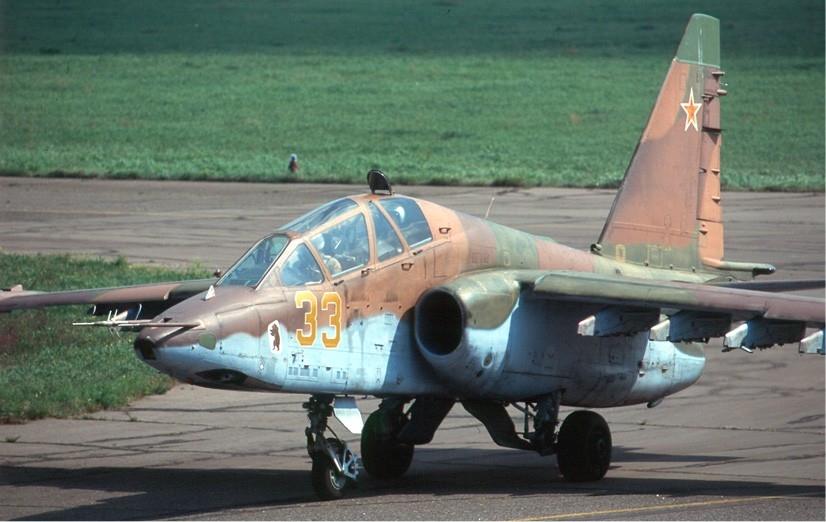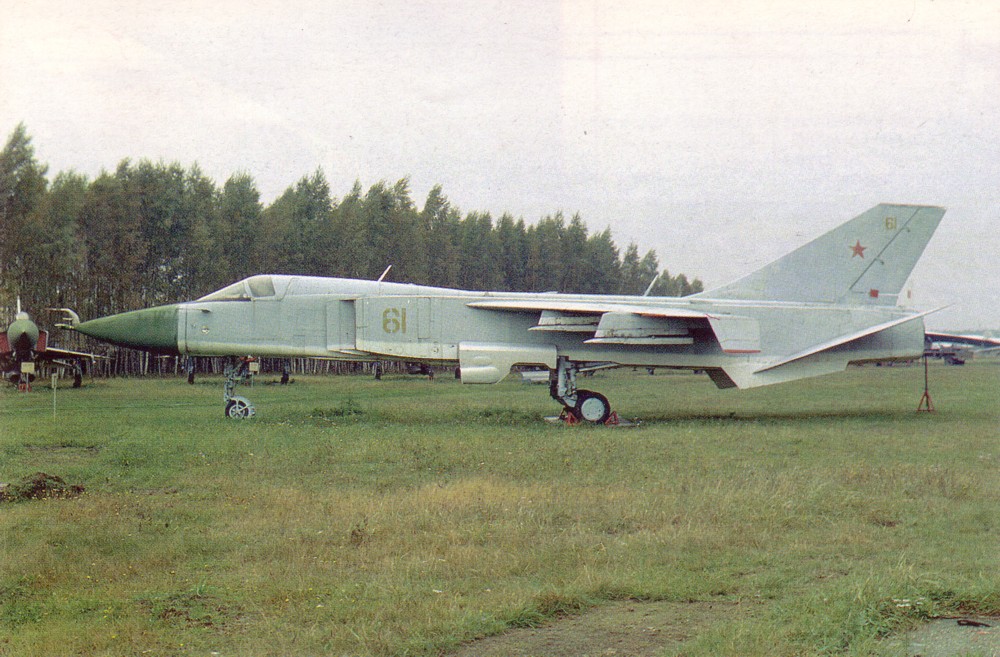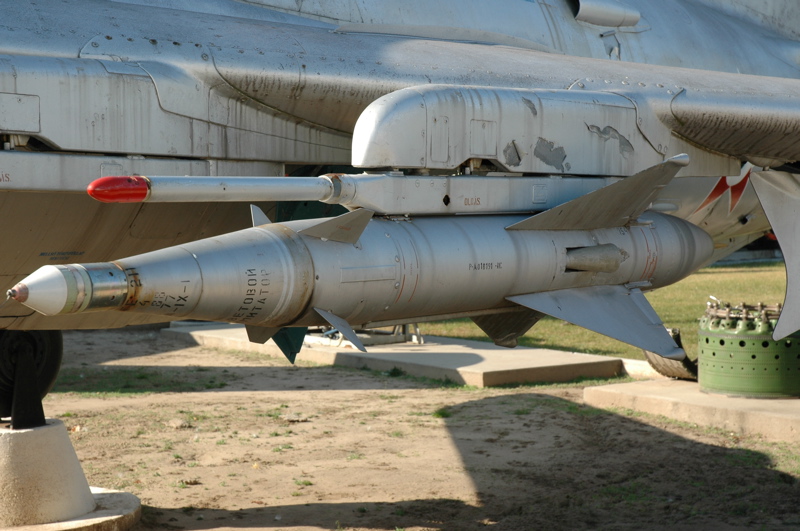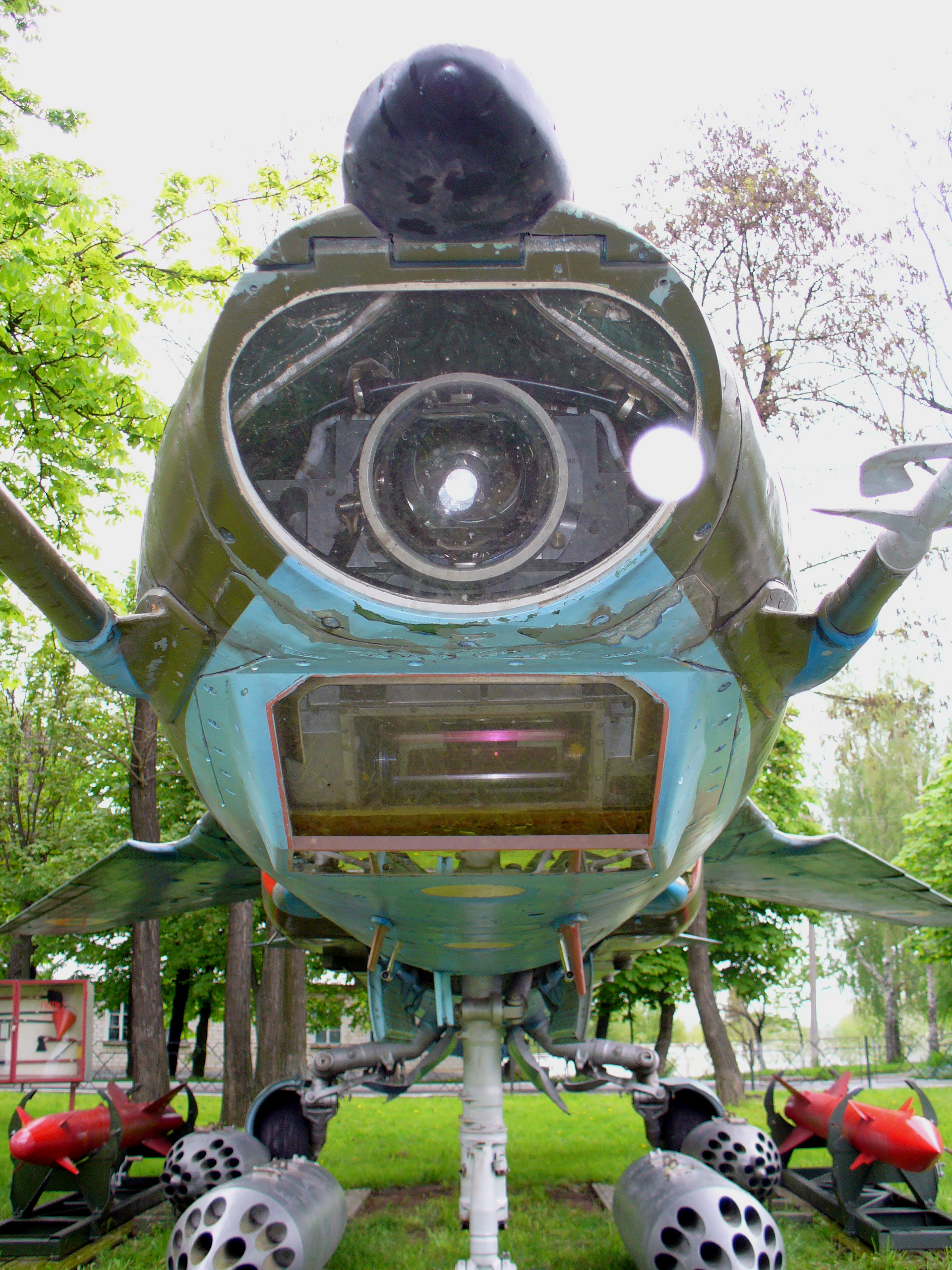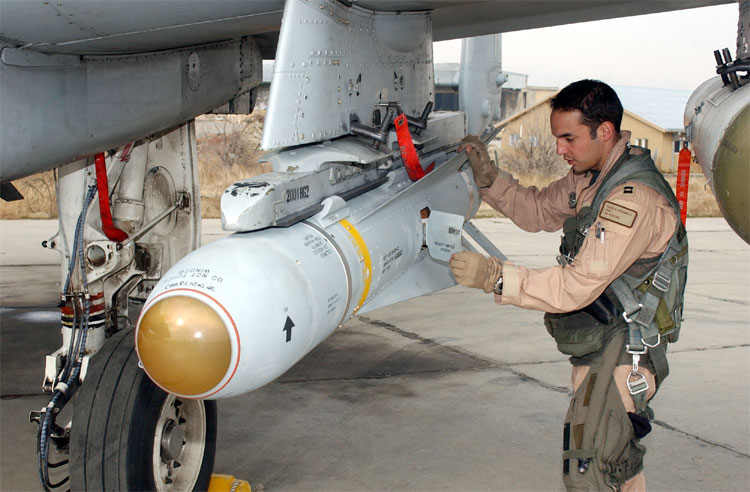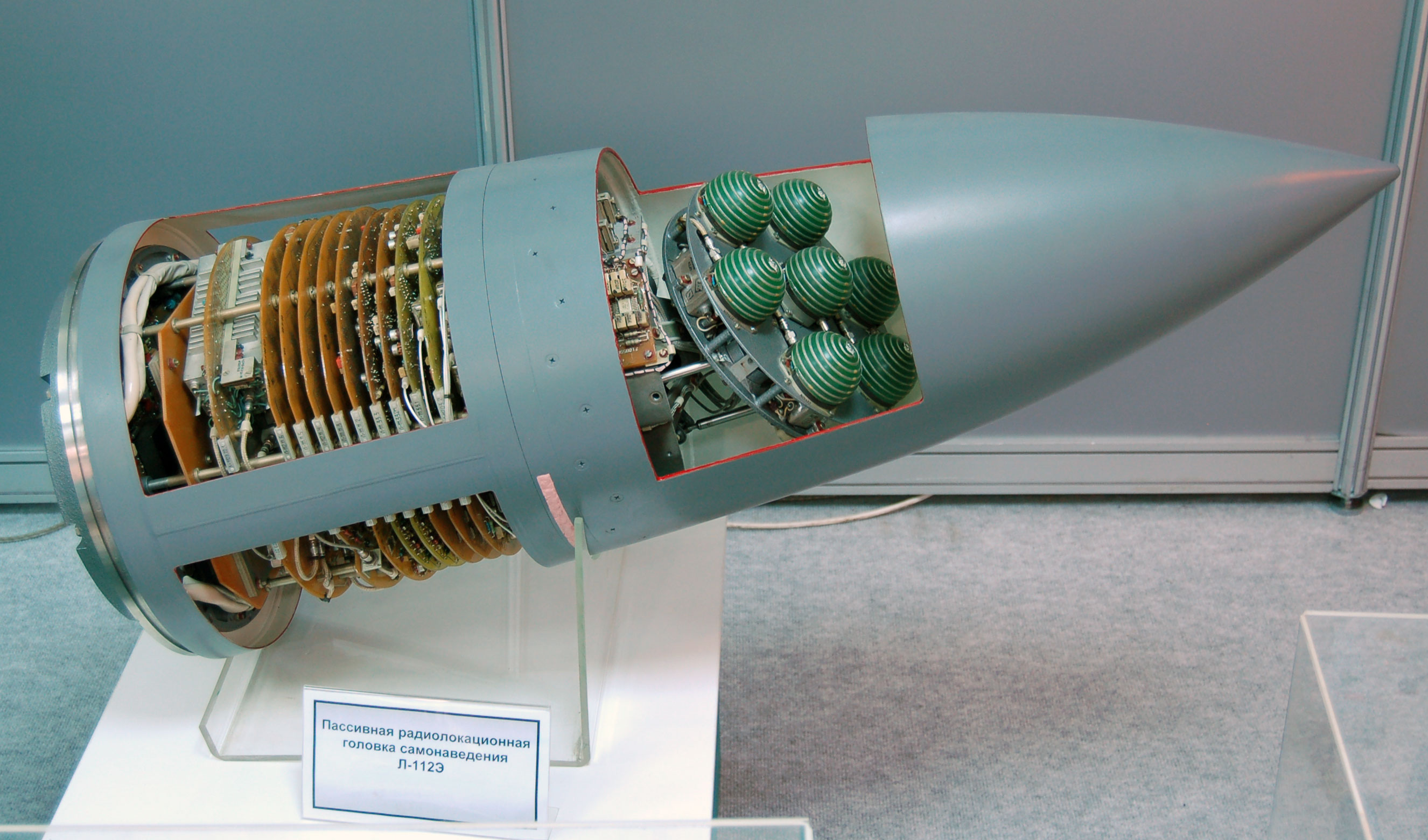|
Kh-25
The Kh-25/Kh-25M (; NATO: AS-10 'Karen) is a family of Soviet lightweight air-to-ground missiles with a modular range of guidance systems and a range of 10 km. The anti-radiation variant (Kh-25MP) is known to NATO as the AS-12 ' Kegler and has a range up to 40 km. Designed by Zvezda-Strela, the Kh-25 is derived from the laser-guided version of the Kh-23 Grom (AS-7 'Kerry'). The Kh-25 remains in widespread use despite the apparent development of a successor, the Kh-38. Development Based on an air-to-air missile, the beam-riding Kh-66 had been the Soviet Union's first air-to-ground missile for tactical aircraft, entering service in 1968. However it proved difficult to use in practice as the launch aircraft had to dive towards the target. A version with radio-command guidance, the Kh-23, was first tested in 1968 but problems with the guidance system meant that it would not enter service for another five years. So in 1971 work began on a version with a semi-active lase ... [...More Info...] [...Related Items...] OR: [Wikipedia] [Google] [Baidu] |
Sukhoi Su-17
The Sukhoi Su-17 (''izdeliye'' S-32; NATO reporting name: Fitter) is a variable-sweep wing fighter-bomber developed for the Soviet military. Developed from the Sukhoi Su-7, the Su-17 was the first variable-sweep wing aircraft to enter Soviet service and featured updated avionics. The aircraft also has variants which were designed to be exported to non-Soviet states such as the Sukhoi Su-22 and the less popular Su-20. It was produced from 1967 to 1990. The Su-17/20/22 series had a long career and has been operated by many air forces, including those of the Russian Federation, former Soviet republics, former Warsaw Pact, countries in the Arab world, Angola, and Peru. The Russian Federation retired its fleet in 1998. Although the Su-17 was capable of carrying nuclear weapons, it was used in roles ranging from close-air support to ground attack. Development Shortly after the Su-7 fighter-bomber was put into service, the Sukhoi Design Bureau was ordered to develop a modernization ... [...More Info...] [...Related Items...] OR: [Wikipedia] [Google] [Baidu] |
Sukhoi Su-25
The Sukhoi Su-25 ''Grach'' ( ('' rook''); NATO reporting name: Frogfoot) is a subsonic, single-seat, twin-engine jet aircraft developed in the Soviet Union by Sukhoi. It was designed to provide close air support for Soviet Ground Forces. The first prototype made its maiden flight on 22 February 1975. After testing, the aircraft went into series production in 1978 in Tbilisi in the Georgian Soviet Socialist Republic. Early variants included the Su-25UB two-seat trainer, the Su-25BM for target-towing, and the Su-25K for export customers. Some aircraft were upgraded to the Su-25SM standard in 2012. The Su-25T and the Su-25TM (also known as the Su-39) were further developments, not produced in significant numbers. The Su-25, and the Su-34, were the only armoured, fixed-wing aircraft in production in 2007.Gordon and Dawes 2004. Su-25s are in service with Russia, other CIS members, and export customers. Production of the Su-25 ended in 2010 in Georgia. Attempts continue to b ... [...More Info...] [...Related Items...] OR: [Wikipedia] [Google] [Baidu] |
Sukhoi Su-24
The Sukhoi Su-24 (NATO reporting name: Fencer) is a supersonic, night fighter, all-weather tactical bomber developed in the Soviet Union. The aircraft has a variable-sweep wing, Twinjet, twin engines and a side-by-side seating arrangement for its crew of two. It was the first of the USSR's aircraft to carry an integrated digital Nav/attack system, navigation/attack system. The Su-24 started development in the early 1960s and first flew in 1967. It entered service in 1974 and production ceased in 1993. It remains in service with the Russian Aerospace Forces, Syrian Air Force, Ukrainian Air Force, Algerian Air Force and various other air forces to which it was exported. Development Background One of the conditions for accepting the Sukhoi Su-7, Sukhoi Su-7B into service in 1961 was the requirement for Sukhoi to develop an all-weather variant capable of precision air strikes. Preliminary investigations with ''S-28'' and ''S-32'' aircraft revealed that the basic Su-7 design was to ... [...More Info...] [...Related Items...] OR: [Wikipedia] [Google] [Baidu] |
Su-25
The Sukhoi Su-25 ''Grach'' ( ('' rook''); NATO reporting name: Frogfoot) is a subsonic, single-seat, twin-engine jet aircraft developed in the Soviet Union by Sukhoi. It was designed to provide close air support for Soviet Ground Forces. The first prototype made its maiden flight on 22 February 1975. After testing, the aircraft went into series production in 1978 in Tbilisi in the Georgian Soviet Socialist Republic. Early variants included the Su-25UB two-seat trainer, the Su-25BM for target-towing, and the Su-25K for export customers. Some aircraft were upgraded to the Su-25SM standard in 2012. The Su-25T and the Su-25TM (also known as the Su-39) were further developments, not produced in significant numbers. The Su-25, and the Su-34, were the only armoured, fixed-wing aircraft in production in 2007.Gordon and Dawes 2004. Su-25s are in service with Russia, other CIS members, and export customers. Production of the Su-25 ended in 2010 in Georgia. Attempts continue to be ma ... [...More Info...] [...Related Items...] OR: [Wikipedia] [Google] [Baidu] |
Kh-38
The Kh-38/Kh-38M () is a family of standoff air-to-surface missiles meant to succeed the Kh-25 and Kh-29 missile families. The Kh-38 also serves as the basis for the Kh-36 unpowered and powered glide-bombs. Design and development The basic configuration of the Kh-38M was revealed at the 2007 Moscow Air Show (MAKS). The first prototypes of the missile had initially folding wings and tail fins for internal carriage, and would have a variety of seeker heads for different variants. Different warheads (fragmentation, cluster munitions, penetrating) can also be fitted. The Kh-38M is meant to succeed the Kh-25 and Kh-29 missile families. It can be used by combat aircraft such as the Sukhoi Su-34 and Sukhoi Su-57, and it is planned to be integrated on the Kamov Ka-52K helicopter. The first test firing took place in 2010 from a Su-34, and production was ordered to start in 2015. In a successive version, unveiled at MAKS 2017, both control surfaces were replaced by longer and narrow ... [...More Info...] [...Related Items...] OR: [Wikipedia] [Google] [Baidu] |
Kh-23 Grom
The Zvezda Kh-66 and Kh-23 ''Grom'' ( 'Thunder'; NATO: AS-7 'Kerry') are a family of early Soviet tactical air-to-surface missiles with a range of 10 km. They were intended for use against small ground or naval targets. The Kh-66 was effectively a heavy-warhead, beam-riding version of the K-8 (AA-3 'Anab') air-to-air missile rushed into service in Vietnam in 1968. The Kh-23 was an improved Kh-66 with command-guidance, similar to the AGM-12 Bullpup. Development Work on air-to-air missiles had started at the Kaliningrad Engineering Plant (then known as Plant #455, and later merged into Zvezda-Strela) in 1955. This had resulted in the Kaliningrad K-5 (AA-1 'Alkali') family of beam-guided missiles, including the K-51 (RS-2-US) carried by the Su-9 'Fishpot'. OKB-4 Molniya (later Vympel NPO) under Matus Bisnovat would go on to produce missiles such as the AA-6 Acrid. Meanwhile, in 1963 the RS-2-US was tested as an air-to-surface missile. It was concluded that the small warhead a ... [...More Info...] [...Related Items...] OR: [Wikipedia] [Google] [Baidu] |
Active Radar Homing
Active radar homing (ARH) is a missile guidance method in which a missile contains a radar transceiver (in contrast to semi-active radar homing, which uses only a passive radar, receiver) and the electronics necessary for it to find and track its target autonomously. The NATO brevity code for an air-to-air active radar homing missile launch is fox (code word), Fox Three. Advantages There are two major advantages to active radar homing: * As the missile is tracking the target it is going to be much closer to the target than the launching platform during the terminal phase, thus the missile's tracking can be much more accurate and better resistant to electronic countermeasures. Active radar homing missiles have some of the best kill probability, kill probabilities, along with missiles employing track-via-missile guidance. * Because the missile is totally autonomous during the terminal phase, the launch platform does not need to have its radar enabled at all during this phase, an ... [...More Info...] [...Related Items...] OR: [Wikipedia] [Google] [Baidu] |
Mikoyan-Gurevich MiG-27
The Mikoyan MiG-27 (; NATO reporting name: Flogger-D/J) is a variable-sweep ground-attack aircraft, originally built by the Mikoyan-Gurevich design bureau in the Soviet Union and later licence-produced in India by Hindustan Aeronautics as the ''Bahadur'' ("Valiant"). It is based on the Mikoyan-Gurevich MiG-23 fighter aircraft, but optimised for air-to-ground attack. Unlike the MiG-23, the MiG-27 did not have widespread use outside Russia, as most countries opted for the Mikoyan-Gurevich MiG-23BN and Sukhoi Su-22 instead. As of late 2023, all Russian, Indian, Sri Lankan, Ukrainian, and Kazakh MiG-27s have been retired, bringing the type's service to an end. Design and development The MiG-27 shares the basic airframe of the MiG-23, but with a revised nose – nicknamed "''Utkonos''" ("Platypus") or "'' Krokodil Gena''" in Russian service, first introduced on the MiG-23B. Dissatisfaction with the MiG-23BN led to the further development of the basic airframe to accommodate a ... [...More Info...] [...Related Items...] OR: [Wikipedia] [Google] [Baidu] |
Air-to-surface Missile
An air-to-surface missile (ASM) or air-to-ground missile (AGM) is a missile designed to be launched from military aircraft at targets on land or sea. There are also unpowered guided glide bombs not considered missiles. The two most common propulsion systems for air-to-surface missiles are rocket motors, usually with shorter range, and slower, longer-range jet engines. Some Soviet Union, Soviet-designed air-to-surface missiles are powered by ramjets, giving them both long range and high speed. Missile guidance, Guidance for air-to-surface missiles is typically via laser guidance, infrared homing, infrared guidance, optical guidance or via satellite guidance signals. The type of guidance depends on the type of target. Ships, for example, may be detected via passive radar or active radar homing, which is less effective against multiple, small, fast-moving land targets. There is some cross-over between air-to-surface missiles and surface-to-surface missiles. For example, there was ... [...More Info...] [...Related Items...] OR: [Wikipedia] [Google] [Baidu] |
Kh-31
The Kh-31 (; AS-17 'Krypton') is a Soviet and Russian air-to-surface missile carried by aircraft such as the MiG-29, Su-35 and the Su-57. It is capable of Mach number, Mach 3.5 and was the first supersonic anti-ship missile that could be launched by tactical aircraft. There are several variants; the Kh-31 is best known as an anti-radiation missile (ARM) but there are also anti-ship and target drone versions. There has been talk of adapting it to make an "Airborne early warning and control, AWACS killer", a long-range air-to-air missile. Development The proliferation of surface-to-air missiles (SAMs) has made the Suppression of Enemy Air Defences (SEAD) a priority for any modern air force intending offensive action. Knocking out air search radars and fire control radars is an essential part of this mission. ARMs must have standoff (missile), sufficient range that the launch platform is out of range of the SAMs, high speed to reduce the risk of being shot down and a seeker that can ... [...More Info...] [...Related Items...] OR: [Wikipedia] [Google] [Baidu] |


